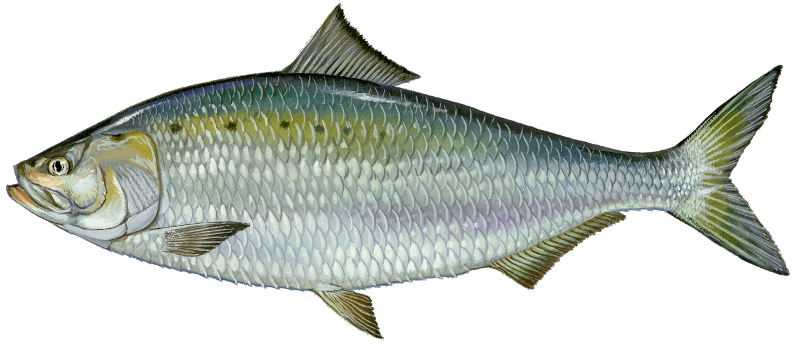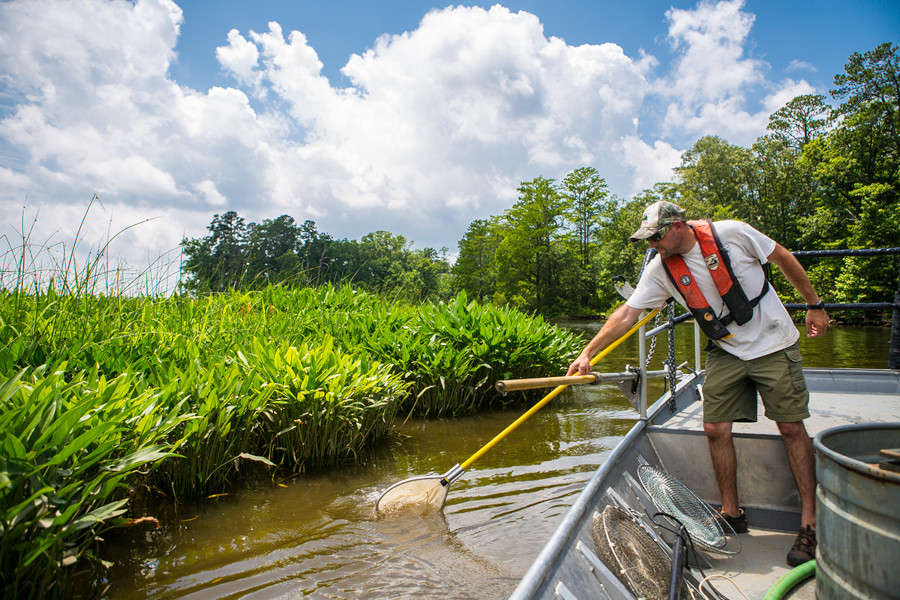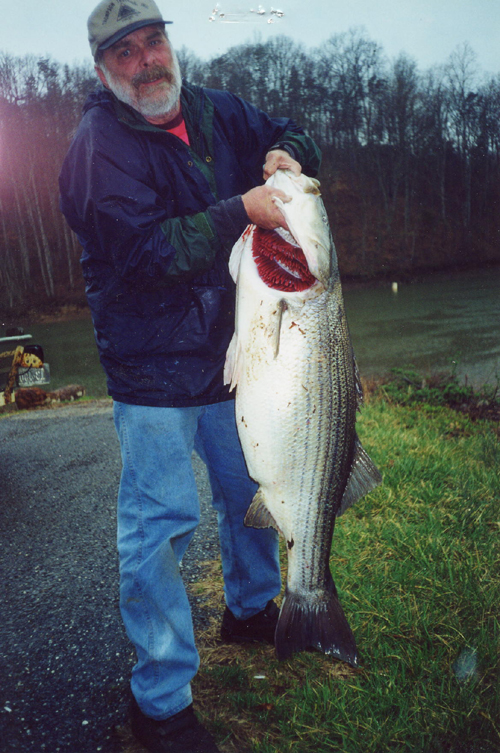
American shad (Alosa sapidissima)
Source: US Fish and Wildlife Service Image Library, American Shad (by Duane Raver)
different species of anadromous fish migrate into fresh water each Spring
Source: Chesapeake Bay Program, From the Field: Opening the door for migrating fish
Each February, when water temperature climbs to 45-50°, the yellow perch (Perca flavescens) start moving from deep water to spawn in shallow tributaries. The yellow perch have spent most of the year in the brackish water near the mouth of the river, and migrate upstream to spawn in the freshwater section of the same river.
The anadromous fish migrations start later with cycles of alewife herring (Alosa pseudoharengus), hickory shad (Alosa mediocris), American shad (Alosa sapidissima), and finally blueback herring (Alosa aestivalis).1
Source: Virginia Institute of Marine Science (VIMS), Chesapeake Bay Fishes
In April, American shad spawn in the rivers along the Chesapeake Bay. These are anadromous fish, like the steelhead and the salmon in the Pacific Northwest. Anadromous fish spend most of their life in salt water but migrate to fresh water for spawning. American eels do the reverse, spawning in the Sargasso Sea but returning to spend most of their lives in fresh water.
After depositing their eggs into the brackish estuaries, the shad swim downstream, exit the Chesapeake Bay between Cape Charles and Cape Henry, and turn left. They spend the summer in northern waters, such as the Bay of Fundy and the Gulf of Maine.
There, in the cold waters above the coastal shelf and Georges Bank and west of the Gulf Stream, the shad feed and grow. In the fall, they migrate south again and spend the winter off the Carolina coastline. Come spring, the cycle is repeated with a new round of spawning in the estuaries. If you could put an odometer on a shad, the measuring device would need 4 digits, rolling past "999" and then "1,999" miles annually.

American shad (Alosa sapidissima)
Source: US Fish and Wildlife Service Image Library, American Shad (by Duane Raver)
So a shad, a striped bass (rockfish), and other anadromous species look at Virginia as a part-time home. "Virginia is for lovers" could apply to fish as well as tourists. But for the fish, Virginia is not a safe haven. There are numerous dams blocking the way, creating impossible-to-leap barriers far more challenging than the natural waterfalls. Then the water quality is poor, at times. And assuming a fish survived its visit to Canadian waters, the winter in the Atlantic Ocean, and the trip to the spawning grounds - there are those Virginia fishermen waiting in April.
Shad roe, the large egg sacs of spawning females, has been served in Virginia homes long before Jamestown was founded... though those homes may have been Algonquian longhouses.
If you're the governor of Virginia rather than a fish, you can't go it alone to restore a fishery. Even the rockfish, which spends two-thirds of its lifespan in the Chesapeake Bay, is dependent upon water quality from New York, Pennsylvania, West Virginia, and Maryland as well as Virginia. Bottom line: If the governor of Virginia wants to protect or restore natural populations of fish, or migratory birds, then he or she will need to cooperate with the neighbors and the Federal government.
Before the Ice Age, and afterwards, each Virginia river had the potential of establishing unique species of fish, and especially subspecies (strains) that reflected adaptation to the particular environment of each watershed. Overharvest of the fish, excessive siltation from agriculture and timber harvest, blockage of fish passage by dams, chemical pollution by industrial plants, and 50 years of pesticides all degraded the aquatic habitats in Virginia.
As a result, much of the genetic diversity of Virginia's rivers was lost. Restocking of hatchery fish brought non-native genes, and even non-native species, to Virginia watersheds. The apparent recovery of the fish populations (in some cases) disguises the weakness of the reduced diversity. The current fish populations are not as pre-adapted to the stresses they may face... but then again, the stresses have changed dramatically as well in the last 400 years.
Genetic analysis of the bass populations in Virginia reveal they include a mixture of genes from Northern largemouth bass (Micropterus salmoides salmoides) and Florida largemouth bass (Micropterus salmoides floridanus). Populations typically have 40% to 60% Florida genes; there are no largemouth populations in Virginia with just Northern or Florida genes.
To generate trophy fish at Smith Mountain Lake, the Virginia Department of Wildlife Resources intentionally bred two subspecies of bass. They created an "intergrade," the equivalent of creating a "hybrid" from crossbreeding two separate species.
The first generation (F1) of offspring from crossbreeding the Northern and Florida largemouth basswill grow faster than the native bass in Virginia. In 2021, the state agency stocked large reservoirs with the intergrade, sometimes known as "tiger bass," as an experiment that will require 10-12 years to evaluate:2

stocking F1 largemouth bass fingerlings into the Chickahominy River
Source: Virginia Department of Wildlife Resources, DWR’s F1 Largemouth Bass Stocking Program FAQ
Does genetic diversity really have an impact? It may be hard to measure the effects in the state's fish populations, but every winter the 6.8 million humans in Virginia demonstrate the importance of being adapted.
When the annual influenza epidemics hit, and the sneezes and coughs and aches begin, a certain percentage of those humans discover far too effectively that they are not resistant to the newest strain of the flu virus. The genetic diversity of influenza changes more rapidly than the genetic diversity of shad or trout. The changes in the strains of flu creates impacts that are far more obvious (and far more often) than the changes in the strains of fish. In Virginia's aquatic ecosystems, however, the annual arrival of the flu is irrelevant compared to the annual arrival of the anadromous fish... it all depends on your frame of reference.

a record-sized striped bass (over 53 pounds) was caught in Leesville Reservoir by James B. Davis in 2000
Source: Virginia Department of Game and Inland Fisheries (DGIF), Virginia State Record Fish
Source: Arlington County, Arlington's Streams